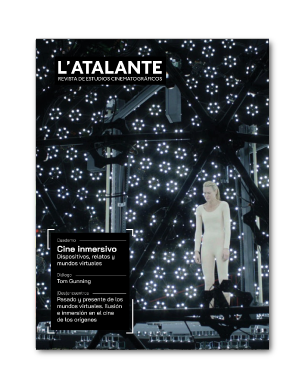The Blurred Lines Between Spectator and Character: Narrative Integration of the User in Cinematic Virtual Reality
Publicades 2023-01-01
Paraules clau
- Virtual Reality,
- Immersion,
- Cinematic Virtual Reality,
- Focalization,
- Presence
- Agency,
- Character,
- User. ...Més
Com citar
Resum
In spite of the intense sense of immersion that Virtual Reality (VR) can incite, the interactivity of the user is always limited. In traditional narrative VR pieces, also known as cinematic VR (CVR), users can witness a story but can hardly impact it. This limitation creates a paradox in which users feel immersed in a virtual world but cannot interact with it. This article focuses on the narrative strategies used in CVR to integrate spectators within the diegesis. This paradox of immersion behooves scholars and creatives to rethink traditional narrative paradigms to apply them to this new medium. In this sense, the user’s limited ability to interact needs to reinforce the overall narrative premise. By analyzing a corpus of live-action CVR pieces, this article proposes a typology of users: different ways in which the spectator can be integrated in the story, navigating the overlaps between user, character, and focalizer successfully.
Descàrregues
Referències
Banakou, D., Slater, M. (2014). Body Ownership Causes Illusory Self-Attribution of Speaking and Influences Subsequent Real Speaking. <em>Proceedings of the National Academy of Sciences of the United States of America, 111</em>(49), 17678–17683. https://doi.org/10.1073/pnas.1414936111 <br>
Biocca, F. (2002). The Evolution of Interactive Media: Toward ‘Being There’ in Nonlinear Narrative Worlds. In M. Green, M. Strange, and T. Brock, (Eds.), <em>Narrative Impact: Social and Cognitive Foundations</em> (pp. 97-130). Mahwah, NJ: Erlbaum.<br>
Blascovich, J., Loomis, J., Beall, A., Swinth, K., Hoyt, C., Bailenson, J. (2002). Immersive Virtual Environment Technology as a Methodological Tool for Social Psychology. <em>Psychological Inquiry, 13</em>(2), 103-124. https://doi.org/10.1207/S15327965PLI1302_01 <br>
Bollmer, G. (2017). Empathy Machines. <em>Media International Australia, 165</em>(1), 63-76. https://doi.org/10.1177/1329878X17726794<br>
Burch, N. (1979). Film’s Institutional Mode of Representation and the Soviet Response. <em>October, 11</em>, 77-96. https://doi.org/10.2307/778236 <br>
Dooley, K. (2018). Virtual Reality: Moving Beyond a Cinema of the Attractions. <em>Screen Education, 88</em>, 96-103.<br>
Durán Fonseca, E., Rubio-Tamayo, J.L., Alves, P. (2021). Niveles de diseño narrativo, espacial y de interacción para el desarrollo de contenidos en el medio de la realidad virtual. <em>ASRI, 19,</em> 96 -111.<br>
Edwards, S. (2017, February 4). Virtual Reality Is Here To Stay and It Needs Screenwriters. <em>Screenwriting Magazine</em>. Recuperado de https://screenwritingmagazine.com/2017/02/04/virtual-reality-stay-needs-screenwriters<br>
Elseasser, T., Hagener, M. (2010). <em>Film Theory: An Introduction Through the Senses</em>. Routledge.<br>
Gaudreault, A., Jost, F. (1990).<em> Le récit cinématographique</em>. Paris: Éditions Nathan.<br>
Fauville, G., Queiroz, A.C.M., Bailenson, J.N. (2020). Virtual reality as a promising tool to promote climate change awareness. En J. Kim, H. Song, (Eds.), <em>Technology and Health: Promoting Attitude and Behavior Change</em> (pp. 91-108). Elsevier. https://doi.org/10.1016/B978-0-12-816958-2.00005-8<br>
Gödde M., Gabler F., Siegmund D., Braun A. (2018). Cinematic Narration in RV: Rethinking Film Conventions For 360 Degrees. En Chen J., Fragomeni G. (Eds), <em>Virtual, Augmented and Mixed Reality: Applications in Health, Cultural Heritage, and Industry. VAMR 2018. Lecture Notes in Computer Science, 10910</em>. https://doi.org/10.1007/978-3-319-91584-5_15<br>
Gubern, R. (1996). <em>Del bisonte a la realidad virtual: La escena y el laberinto. </em>Barcelona: Anagrama.<br>
Mateer, J. (2017). Directing for Cinematic Virtual Reality: How The Traditional Film Director’s Craft Applies to Immersive Environments and Notions of Presence. <em>Journal of Media Practice, 18</em> (1), 14-25. https://doi.org/10.1080/14682753.2017.1305838 <br>
Jones, M. (2017, January 27). <em>Interview for Screen Australia</em>. Recuperado de https://www.youtube.com/watch?v=U1rhfPz9f8k&feature=youtu.be<br>
Meyer, K. (1995). Dramatic Narrative in Virtual Reality.’ En F. Biocca, and M.R. Levy (Eds), <em>Communication in the Age of Virtual Reality </em>(pp. 219–258). New York: Routledge.<br>
Murray, J. H. (2020). Virtual/Reality: How To Tell The Difference. <em>Journal of Visual Culture, 19</em> (1), 11–27. https://doi.org/10.1177%2F1470412920906253<br>
Nash, K. (2022). <em>Interactive Documentary. Theory and Debate.</em> New York: Routledge.<br>
Ramirez, Erick (2018, October 26). It’s Dangerous to Think Virtual Reality is an Empathy Machine. <em>Aeon</em>. Recuperado de https://aeon.co/ideas/its-dangerous-to-think-virtual-reality-is-an-empathy-machine<br>
Rath-Wiggins, L. (2016, February 25). Writing for RV? Three Things to Remember! <em>Get Fader</em>. Recuperado de https://getfader.com/writing-for-RV/<br>
Roswell, R. O., Cogburn, C. D., Tocco, J., Martinez, J., Bangeranye, C., Bailenson, J. N., Wright, M., Mieres, J. H., & Smith, L. (2020). Cultivating Empathy Through Virtual Reality: Advancing Conversations About Racism, Inequity, and Climate in Medicine. <em>Academic Medicine, 95</em>(12), 1882-1886.https://doi.org/10.1097/ACM.0000000000003615<br>
Ryan, M. L. (2001). <em>Narrative as Virtual Reality: Immersion and Interactivity in Literature and Electronic Media</em>. Baltimore: Johns Hopkins University Press.<br>
Santesmases, M. (2020, May 4). Narrative RV trends in 360. A View From The Tunnel Under Tribeca. <em>Medium</em>. Recuperado de https://medium.com/@miguel.santesmases/narrative-vr-trends-in-360-a-view-from-the-tunnel-under-tribeca-d6f6a238503c <br>
Shin, D. (2018). Empathy and Embodied Experience in Virtual Environment: To What Extent Can Virtual Reality Stimulate Empathy And Embodied Experience? <em>Computers in Human Behavior,</em>
<em>78</em>. 64-73. https://doi.org/10.1016/j.chb.2017.09.012 <br>
Stanney, K., Fidopiastis, C., Foster, L. (2020). Virtual Reality is Sexist, But It Does Not Have To Be. <em>Frontiers in Robotics and AI, 7</em>(4), 1-19. https://doi.org/10.3389/frobt.2020.00004 <br>
Slater, M., Wilbur, S. (1997). A Framework for Immersive Virtual Environments (FIVE): Speculations on the role of presence in virtual environments. <em>Presence: Teleoperators & Virtual Environments 6</em>, 603-616. https://doi.org/10.1162/pres.1997.6.6.603<br>
Wolterbeek, M. (2018, June 21). Exploring How To Make Virtual Reality More Accessible To Women. <em>Nevada Today</em>. Recuperado de https://www.unr.edu/nevada-today/news/2018/vr-sickness-in-women</p>

